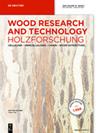中国竹子维管束形态的径向分布:快速采样和分类的机器学习方法
IF 1.6
3区 农林科学
Q2 FORESTRY
引用次数: 1
摘要
摘要:由于人工测量的繁琐,不同属种竹子的茎壁解剖特征的变化,即维管束的形状和大小分布,尚未得到很好的了解。利用机器学习方法,提出了一种通用的维管束检测模型,用于快速、可靠和自动地表征中国23属213种竹子的茎横截面维管束。维管束数量和纤维鞘面积分别与外周长和壁厚呈线性正相关。维管束分布密度与外周长和管壁厚度呈衰减指数相关。平均纤维体积分数为35.2%±7%,种间差异较小。根据维管束径向长度和切向长度的内表皮分布模式可分为3类,径向与切向比例可分为2类,纤维鞘面积分布模式可分为4类。讨论了竹材分类、结构和制浆造纸应用的意义。本研究结果为建立统一、权威、客观的基于维管组织形态的竹分类体系奠定了基础。本文章由计算机程序翻译,如有差异,请以英文原文为准。
Radial distribution of vascular bundle morphology in Chinese bamboos: machine learning methodology for rapid sampling and classification
Abstract Variation in anatomical features of the culm wall namely the shape and size distributions of vascular bundles between different genera and species of bamboo is not well understood due to the cumbersome task of manual measurements. Using machine learning methodology, this work presents a universal vascular bundle detection model for rapid, reliable, and automatic characterization of vascular bundles in culm cross sections of 213 species across 23 genera of Chinese bamboos. The number of vascular bundles and the fiber sheath area have positive linear correlations with the outer circumference and the wall thickness, respectively. The distribution density of vascular bundles has a decay exponential correlation with the outer circumference and the wall thickness. The average fiber volume fraction was 35.2 % ± 7 % with relatively small variation between species. Bamboo species could be grouped into three categories based the endodermis to epidermis distribution pattern of radial and tangential length of vascular bundles, two categories of radial-to-tangential ratio and four categories of fiber sheath area distribution pattern. Implications on bamboo classification, structural and pulp/paper applications were discussed. The findings from this study provide groundwork for the establishment of a unified, authoritative and objective bamboo classification system based on the vascular tissue morphology.
求助全文
通过发布文献求助,成功后即可免费获取论文全文。
去求助
来源期刊

Holzforschung
工程技术-材料科学:纸与木材
CiteScore
4.60
自引率
4.20%
发文量
83
审稿时长
3.3 months
期刊介绍:
Holzforschung is an international scholarly journal that publishes cutting-edge research on the biology, chemistry, physics and technology of wood and wood components. High quality papers about biotechnology and tree genetics are also welcome. Rated year after year as one of the top scientific journals in the category of Pulp and Paper (ISI Journal Citation Index), Holzforschung represents innovative, high quality basic and applied research. The German title reflects the journal''s origins in a long scientific tradition, but all articles are published in English to stimulate and promote cooperation between experts all over the world. Ahead-of-print publishing ensures fastest possible knowledge transfer.
 求助内容:
求助内容: 应助结果提醒方式:
应助结果提醒方式:


